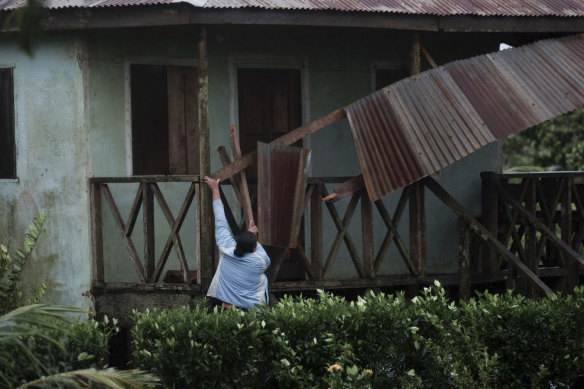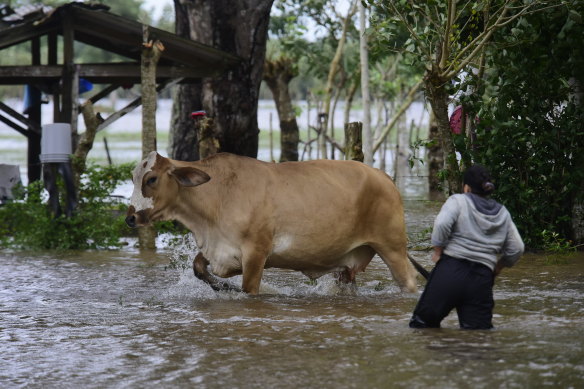- World
- Central America
- Extreme weather
This was published 4 years ago
Hurricane Eta slams Central America
By Oswaldo Rivas
Managua: Hurricane Eta ripped roofs from homes, unleashed major flooding and caused landslides as it battered the coastline of Nicaragua and neighbouring Honduras on Tuesday, US time, reportedly killing at least three people and putting dozens of fishermen in peril.
Eta, one of the most powerful storms to hit Central America in years, plowed into Nicaragua as a category four hurricane on the five-step Saffir-Simpson scale, battering roads and bridges in Honduras. Hundreds of people were evacuated.

A woman works to recover a roof part damaged by hurricane Eta in Wawa, Nicaragua.Credit: AP
Barrelling ashore south of the port of Puerto Cabezas, Eta was expected to cause "catastrophic" wind damage as the eye of the storm moved inland along the northeastern coast of Nicaragua, the U.S. National Hurricane Center (NHC) said.
When it struck the coast, Eta was blowing potentially devastating winds of 225 km/h the NHC said. The storm should weaken rapidly as it advances inland, it added.
By 6pm local time the winds had eased to 177 km/h, reducing Eta to a category two storm.
Nicaraguan media reported that two artisanal miners were killed by a mudslide. In Honduras, a 13-year-old girl died in a landslide on her home, the fire department said.

A woman takes cattle to a safe area in El Triunfo de la Cruz, Tela, Honduras. Credit: Getty Images
Meanwhile, about 60 fishermen were trapped and in danger in the eastern Mosquitia region of Honduras, according to Robin Morales, a representative of the local population.
The fishermen "remain adrift at sea shouting for help", Morales said, adding that a Honduran Navy official told him it was currently too dangerous to mount a rescue operation.
"If they aren't rescued, I don't think these people will remain alive for more than 24 hours," Morales said.
By early Tuesday, Eta had knocked down trees and power lines and caused serious flooding in northeast Nicaragua, disaster management agency SINAPRED said. Still, Vice President Rosario Murillo said the initial damage had been less than feared.
"We're really afraid, there are fallen poles, there's flooding, roofs torn off, some of the zinc on my house fell off," said Carmen Enriquez, a resident of Puerto Cabezas.
The indigenous regions in northern Nicaragua are some of the country's poorest. Many people live in homes made of wood and adobe that are ill-equipped to withstand such a powerful storm.
Earlier, Javier Plat, a Catholic priest, had said there was a citywide power outage in Puerto Cabezas and government-arranged shelters had reached capacity.
Around 1,227,000 people in Nicaragua, including nearly 500,000 children, were at risk from the storm's fury, the UN children's agency UNICEF said in a statement.
Nicaragua on Monday evacuated at least 3,000 families, including fishermen who live in the most vulnerable villages.
In Honduras, rivers burst their banks, towns and cities on the Atlantic coast flooded, and landslides hit roads.
Eta is forecast to move into northern Nicaragua through Wednesday afternoon and hit central Honduras on Thursday.
Forecasting models then show it snaking back out into the Caribbean over Cuba as a tropical storm toward the end of the week and approaching the tip of the Florida panhandle on Sunday.
Flash and river flooding are also possible in Jamaica, southeast Mexico, El Salvador, southern Haiti and the Cayman Islands, the Miami-based hurricane centre said.
Reuters